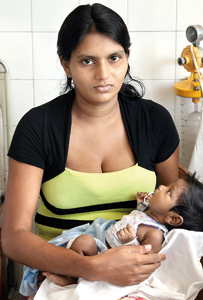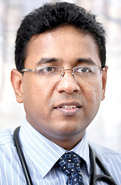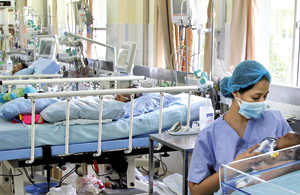A heart-warming journey
View(s):Over 1,600 interventions and heart operations have been performed at the LRH this year free of charge. Kumudini Hettiarachchi reports on a story of dedicated service
Supipi Devmini Nimsara is tiny, not even three months old yet. Tiny she may be but she has already undergone a procedure for a complex heart problem.

Chandrika with baby Aloka. Pix by M.A. Pushpa Kumara
Nala dekaka prashna, says her mother, K.P. Damayanthi Kumarasinghe from Medawachchiya, explaining that too much blood was flowing from Supipi’s heart to her lungs. The little one also had three holes in her heart.
Born on October 26, when a strange sound came from Supipi’s chest, the Anuradhapura Teaching Hospital doctors carried out an echocardiogram and referred mother and daughter to the Lady Ridgeway Hospital (LRH) for Children.
And it was at LRH that the palliative procedure of pulmonary artery banding was performed by the Consultant Cardiothoracic Surgeons.
It was a different procedure that four-year-old who was ready to go home the day the Sunday Times visited the LRH had undergone. His hole in the heart had been closed through an intervention performed in the Catheterisation Laboratory. “A catheter was sent through the groin,” says his mother while the boy is running around happy to be going home.
For six-week-old Asindi Aloka, it was not just one procedure but two. Two of her vessels had got mixed up, explains mother Chandrika Vasanthi from Amapara, pointing out that “apirisindu le” (non-oxygenated blood) and “pirisindu le” (oxygenated-blood) were mixing, while she had four holes in her heart. A narrowing of a blood vessel was corrected by accessing it through the side of her chest and open-heart surgery ensured the closure of the holes in her heart.
These are just a few of the over 1,600 interventions and heart operations that have been performed at the LRH this year absolutely free of charge, thanks to the government heart programme as well as the silent but solid support of many donors including the Children’s Heart Project of Sri Lanka. This registered charity with a Board of Directors of eminent professionals drawn from various fields is currently headed by Consultant Paediatric Cardiologist Dr. Duminda Samarasinghe.

Dr. Duminda Samarasinghe
If not for these interventions and operations, the joy of many parents at the birth of their babies would only end in tears. For, the data with regard to children with congenital heart problems cause much heart-burning.
Explaining that about 6 or 8 babies per 1,000 live births are born with a structural abnormality of the heart, Dr. Samarasinghe makes the math easy to work out by giving the estimated live births per year in Sri Lanka as 400,000.
Around 2,500 to 3,000 children are born with heart disease every year, is the disturbing and heartrending fact.
Referring to the measures needed to save the lives of these children, Dr. Samarasinghe says that when taking the spectrum of congenital heart diseases, there will be a small category with small lesions for which nothing would be needed except medical follow-up. Then, tragically, there would also be less than 1% with such complex heart issues that nothing would help them. The “middle group”, roughly about two-thirds, would need interventions urgently to save their lives.
These interventions could either be simple measures such as closure of holes in the heart or correction of blood vessel or heart valve narrowing with devices in the Cath Lab or more complex measures such as open heart surgery, he says.
Last year the LRH performed 700 catheter interventions and 900 heart operations, the Sunday Times learns.
The target, however, is 1,500 to 2,000 surgeries, points out Dr. Samarasinghe, adding that for most children it would not be a once-and-for-all surgery but repeat operations.

The Cardiac ICU at the LRH
The government has been going all out to care for these children with heart trouble, while also seeing to the health needs of thousands of others, both adults and children, he reiterates, while detailing the “service without fanfare” extended by the Children’s Heart Project.
Started by a group of well-wishers in the 1990s, under the guidance of well-known Cardiologist Dr. P.N. Thenabadu, to improve the quality of care delivered to children with heart disease, the Children’s Heart Project in those early days had facilitated bringing down foreign medical teams to carry out essential treatment or send abroad for treatment seriously-ill children with heart disease. This was long before the LRH heart programme catering to children from all corners of the country was begun, says Dr. Samarasinghe.
With the LRH starting its heart programme, the Children’s Heart Project has shifted gear, providing financial support to complete construction as well as refurbish certain areas of the cardiac complex and purchase equipment and consumables whenever the need arises.
In 2010, the Children’s Heart Project, which utilises only 1% of its funds for administration (charities are dubbed “good” if it is less than 10%), donated an urgently needed portable echocardiogram machine worth Rs. 6 million while also footing the bill of Rs. 2 million for the repair of the High-Dependency Unit which acts as an Intensive Care Unit, the Sunday Times learns.
“When we ran out of cardioplegia delivery sets, each costing Rs. 18,000, and had to stop surgeries as it takes awhile to get them through government due to certain procedures that need to be followed, the Children’s Heart Project stepped in to give 50,” says Dr. Samarasinghe, also citing the valuable ‘Database Project’ for which it donated six computers.
Earlier, the LRH handed over documents with regard to the child-patients to their parents for them to bring those documents back on the next visit. In many instances the parents would misplace or forget these important documents. Now, however, everything is stored in the computers – patient information, echo and cath lab reportsmaking them available at the fingertips of the staff, he says.
With a different single donor paying Rs. 50 million for the construction of two more 24-bed wards for the little cardiac patients of the LRH, which will be completed by mid-2013, there is hope in the new year.
We have reached about 60% of the target but feel we have “a long but definitely reachable way” to clear the backlog, assures Dr. Samarasinghe, calling on people to assist the Children’s Heart Project which has been with the LRH throughout.
Not working for fame, the Children’s Heart Project has not a short-term goal but a far-sighted vision, he is quick to point out, underscoring that it channels donations in the right direction……..the direction of getting the hearts of little ones to beat healthily.
Congenital heart diseases
Although no definite cause has been identified, the contributory factors for congenital heart disease may be a genetic defect, maternal infection such as rubella or the introduction of toxins such as alcohol or drugs.
Congenital heart diseases may be categorised into two groups.
The more complex Cyanotic (those who become blue due to the heart disease) lesions are combinations of holes and narrow valves or under-developed cardiac chambers. The less dangerous Acyanotic (those who remain pink even in the presence of a heart disease) lesions include simple holes in the heart, narrowing of heart valves or incompetence of heart valves.
Tissue Bank– Please help
The LRH has come a long way with regard to children’s heart surgeries but further advancement is essential with a dire need being a Tissue Bank.
Tissues from cadavers which are needed for heart operations including valve repair have to be stored and that’s why we need such a bank. Such tissues, as opposed to commercially available ones, are the best when considering longevity and the risk of rejection, says Dr. Samarasinghe.
‘Hearts in Concert’ with the Revelations is being organised on February 9 and 10, next year, at the Bishop’s College auditorium to raise money for this Tissue Bank.
So all those generous people who have a heartfelt need to help the Children’s Heart Project to pull back children from the brink of death, could buy tickets for the concert or send in a small donation.
Donations may be sent to Account Number 001 232057 001 at the HSBC Colombo 1 branch in the name of the Children’s Heart Project of Sri Lanka. The bank’s swift code is HSBCLKLX.
For information, please contact the Children’s Heart Project of Sri Lanka, No. 8, Tickell Road, Colombo 8. Phone: 00-94-11-5579915; Fax: 00-94-115579950/60 or e-mail: info@childrensheartproject.lk or dsamarasinghe@gmail.com
Follow @timesonlinelk
comments powered by Disqus





















